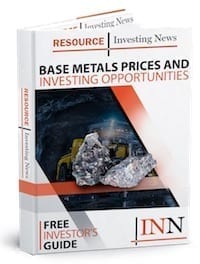Markets and supply chains across the commodities spectrum have taken hits from the COVID-19 pandemic.
Base metal
copper is no exception. Now, some analysts are once again calling for peak copper in much the same way as others have voiced concerns over
peak oil
or
peak gold
.
After the 2008 recession, copper surprised everyone with its rapid ascent — propelled by China’s stockpiling program, it hit record-high prices. In 2011, concerns that peak copper was on the horizon were exacerbated by the rapid industrialization seen in China. As the Asian powerhouse’s copper demand skyrocketed, copper stockpiles had a tough time meeting the increased demand.
That raised the question of when the market reach peak copper. The predictions surrounding the timing of peak copper were are all over the map, ranging from 2020 to 2100.
While it’s clear now that 2020 isn’t the year copper supplies will peak, there are still signs in the red metal’s fundamentals that a tight supply scenario — and higher prices —is on the horizon. Unlike peak
oil
, which was reversed with the help of fracking, no such technological advancements are available for copper production, and there are no viable alternatives to the metal across its many industrial uses.
Copper prices rising on tight supply
In the past decade, strong growth from China has resulted in accelerated copper demand. In a market already known to operate on
thin margins
, Chinese demand has quickly created a copper supply deficit. The potential for other emerging markets to enter periods of rapid growth is
also fueling speculation
that increased demand for copper has only just begun.
Furthermore, interest in copper as an asset class has been piqued, and prices are now being impacted by investment demand in addition to traditional physical demand. Copper is deemed a strategic asset in China, and provides a way to diversify from the US dollar and US treasuries.
In 2011, the tightening balance between copper supply and demand resulted in a rapid rise in the red metal’s prices. Copper hit a low of US$1.32 per pound (US$2,910.09 per tonne) in January 2009, then surged to US$3.55 per pound (US$7,826.40 per tonne) by April 2010 on its way to an all-time peak of $4.58 per pound (more than $10,097 per tonne) in February 2011.
Copper prices have mostly traded under the US$3 (US$6,600) level for the past decade. However, a looming supply crunch, exacerbated by coronavirus-related
supply disruptions
, is pushing prices up again. As of the
close of August 2020
, the price of copper was up 10 percent since the beginning of the year and 58 percent since the COVID-19 lows that hit much of the metals markets in March. The red metal was trading at US$3.065 per pound (US$6,757 per tonne).
Going forward, a long period of undersupply is expected in the copper space, and has the potential to send prices even higher in 2021.
Lagging copper supplies
While copper demand is expected to rise, supply may not keep pace. This is resulting in speculation that we are on the path to peak copper. But according to a
2019 report
out of the University of Iceland, “copper will not run into physical scarcity in the future.”
The Copper Development Association pegs the current known worldwide copper ore
resources
at nearly
5.8 trillion pounds
, of which only about 0.7 trillion pounds, or 12 percent, have been mined throughout history. Plus, nearly all of that mined copper is still in circulation, as the red metals recycling rate is higher than that of any other engineering metal.
So why is the market faced with a supply deficit? The copper supply deficit is not due to a lack of available copper to mine – it is caused by complications in bringing high quality copper to the market.
In an
interview
with Rick Rule at the 2020 Sprott Natural Resource Symposium, the founder of Ivanhoe Mines (TSX:
IVN
,OTCQX:IVPAF) Robert Friedland said, “the copper price probably needs to double its current price for the average low-grade copper porphyry in Peru or in Chile to become viable.”
Back in 2019, Reuters
reported
that “the copper industry has suffered from years of underinvestment, and it is now working feverishly to develop new mines and bring fresh supply online as the electrification trend envelops the global economy.” The expected global copper shortages have major end-users of copper worried about the security of their supply chains, including Tesla (NASDAQ:
TSLA
) as electric vehicles require twice as much copper as their gas powered counterparts.
Copper exploration and mining require a great deal of capital investment. The last major investment cycle was in the 1970s and while, currently, we are in a cycle of increased spending in exploration, new discoveries are few, and have not been enough to compensate for the decline in ore grades from the larger, older mines.
The other big factor impacting new supplies to the market is the time it takes to get a new mine into production. First, an economically viable reserve has to be discovered, and then this discovery has to be developed. Many projects don’t even make it past this point. Often, by the time a mine is about to be constructed, the metal’s price collapses and the project is abandoned.
However, miners who make it past the point of exploration and into construction and mining are faced with a multitude of potentially time consuming delays, including everything from equipment shortages to permitting problems.
Copper inventories low
The worldwide COVID-19 crisis has further impacted the copper supply crunch. “2020 has already seen capex guidance cuts from copper miners and the mine project pipeline is shrinking due to lockdown-related delays,”
said
CEO of Eurasian Resources Group (ERG), Benedikt Sobotka, in July 2020.
Director of Metal Research at Refinitiv Bruce Alway is also concerned about the coronavirus’ impact on copper. “We have recorded sizeable losses for both copper and
zinc
at the mine level, which at the peak saw around 110 operations affected,” he
said
as part of a recent webinar.
Alway said Refinitiv is looking to a mine supply loss of 4 percent compared to 2019, or a drop of more than 800,000 tonnes year-on-year. The world’s first and second biggest copper producers, Peru and Chile, along with the United States are predicted to experience the biggest drops in production. “This represents a (fall of) 550,000 tonnes from our pre-COVID-19 forecast made at the start of 2020, when we were still looking for a decrease, but only a marginal one,” he added.
The London-based metals research firm Roskill
expects
disruptions to mine supply to reach 750,000 tonnes to 1 million tonnes of copper in 2020.
There are also clear signals of tightening further down the supply chain, most notably in China, the world’s largest consumer and third largest producer of copper. In August 2020, Jonathan Barnes, associate consultant for copper at Roskill,
reported
that total visible copper stocks on exchanges and in warehouses have fallen 40 percent from March to below 600,000 tonnes at the end of July. This represents the lowest copper inventories in London Metals Exchange warehouses in 13 years.
“China is importing more refined metal from nearly every country suggesting a structural shift not a temporary change,”
said
Barnes. “If you are looking for signs of panic buying, you can find evidence of that in China – total Chinese stocks represent less than two weeks’ consumption at current rates of use.”
While peak copper may not be a factor, the current fundamentals supporting the copper market are here to stay for the long-term. The ERG’s Sobotka sees the electric vehicle sector adding 1.5 million tonnes of demand over the next decade on top of demand from expanding digital infrastructure. China plans to invest US$3.5 billion in digital infrastructure in 2020, which includes power-intensive data centres and 5G networks.
Robust demand and weak supply are bound to drive copper prices higher. Roskill’s Barnes expects the copper price will likely rise further towards the end of 2020, and that the current environment has strong parallels to the rebound in the copper price after the global financial crisis. “Looking even further ahead, the supply impact of the coronavirus will extend far beyond this year,” said Sobotka said.
Junior copper companies
Keeping all this in mind, there are a still a great deal of copper projects opening up in the coming years, especially from junior miners. It seems that junior miners are the ones bringing on-line most of the new projects. It is important to consider, that these junior miners are a necessity, and they face unique challenges compared to their larger counterparts.
Most significantly is the new credit environment, which may preclude some juniors from gaining the financing necessary to fund their exploration and mining endeavours. These junior miners are very important to the future supply of copper, and many other metals. The large miners, who can easily overcome the financing hurdle, seem more interested in spending money on acquisitions than exploration for new targets.
If you’re an investor interested in junior copper stocks, take a look at our report on the
best junior copper stocks of 2020 on the TSXV
. For investors interested in what the bigger players have to offer, check out
best copper stocks of 2020 on the TSX
.
For more in-depth education on the copper market, please read
Copper Investing: How to Get Started.
Don’t forget to follow us
@INN_Resource
for real-time news updates!
Securities Disclosure: I, Melissa Pistilli, hold no direct investment interest in any company mentioned in this article.
Editorial Disclosure: The Investing News Network does not guarantee the accuracy or thoroughness of the information reported in the interviews it conducts. The opinions expressed in these interviews do not reflect the opinions of the Investing News Network and do not constitute investment advice. All readers are encouraged to perform their own due diligence.





